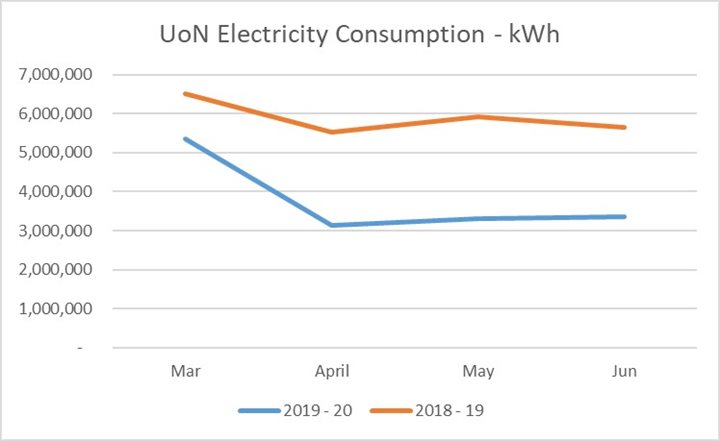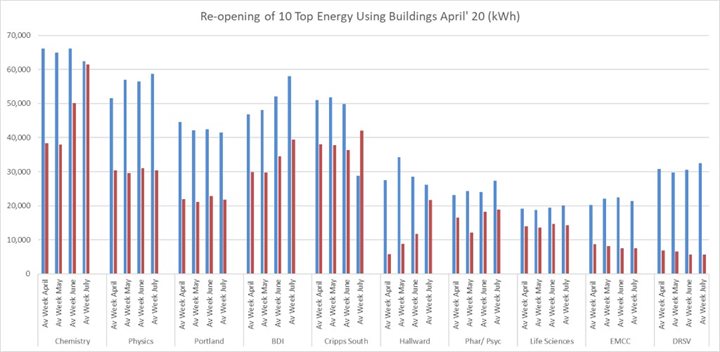In March 2020, the University rapidly closed along with much of the country. The majority of staff and students left campus and over 90% of our buildings were closed; systems were turned off or put into standby and a state of ‘hibernation’ fell across the University in response to the COVID-19 pandemic. Since then, we have worked with building users, technicians and Estates and Facilities staff to turn down equipment. Naturally, such a drastic change has had significant impacts on our energy consumption. We have been monitoring the energy usage in buildings, revealing the impact of our current behaviours on our energy footprint.
Observations
Good news – there has been a substantial reduction in the amount of energy being consumed across the University. On 22 July, electricity consumption had been reduced by over 7million kWh which is equivalent to avoiding nearly 2,000 tonnes of CO2 emissions.

We’ve compared electricity data from the same period in 2018/19 which shows some remarkable reductions. However, it also shows that although buildings were shut there was still significant electricity use powering all manner of necessary equipment (heating, ventilation and cooling in controlled environments), fridges and freezers, some fume cupboards, MRI scanners, etc. The Sir Peter Mansfield building, which continued to power necessary MRI equipment, only had a 14% reduction in electricity usage compared to the same period last year. The Chemistry building, which is home to a mixture of teaching and research labs so some lab equipment could be turned off, reduced its consumption by 37%. These reflections show that by turning off all unnecessary equipment we have and can continue to make real inroads in reducing our energy footprint.
In buildings with minimal specialist or essential equipment, even more significant reductions were observed. Hallward Library consumed 71% less electricity than it did in the same period last year. These reductions illustrate that our behaviours prior to lockdown were very energy intensive, raising the question of how can we alter our habits to reduce our energy consumption.
In June alone, the overall reduction in electricity consumption was equivalent to the grid electricity consumed by Kings Meadow Campus in 2018/19. Similarly, we have seen a reduction in gas consumption during this period: the reduction across the Estate in June compared to last year is equivalent to the gas consumption on Sutton Bonington from February 2020 to June 2020. The prize of these savings is significant – huge carbon savings towards our carbon targets and big financial savings of over £650,000 to the University at a time when it’s never been more important.
Reopening
As buildings reopen, staff return and eventually students too, we expect to see an increase in energy consumption. We are able to analyse the impact of buildings reopening through careful monitoring-- consumption is starting to return levels that were encountered before lockdown.

The graph above identifies the average weekly consumption since April for 2019 (blue) compared to 2020 (red). It can be seen where some buildings are increasing their consumption as they begin to re-open. In contrast to pre-lockdown energy consumptions, we expect that energy usage in halls of residence will be significantly higher as students are expected to spend more time there. This is why we will be working closely with the Student Switch Off campaign to encourage students to be more conscious about consuming energy. We all have a part to play in minimising the increase in energy consumption as we return to campus.
The data collected by our Energy team during the University’s closure has demonstrated that our current habits are very energy intensive. The challenge ahead of us as we return to campus, in terms of our carbon neutrality commitment and the financial saving that must be made, is outlined in ‘The Challenge Ahead’. These insights provide us with useful motivation for where we can make real energy savings. Prior to COVID-19 we knew that we had to reduce our energy footprint; now we have been shown that we can adapt to the dramatic changes in working that will be necessary to reach carbon neutrality.
Posted on Friday 21st August 2020